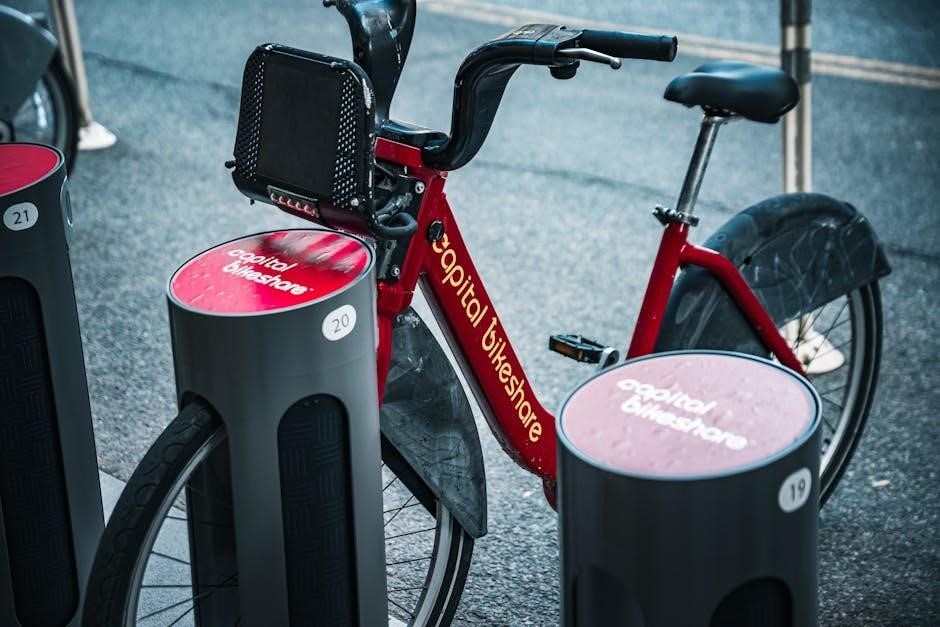The Rain Bird ESP-TM2 is a WiFi-enabled smart irrigation controller designed for efficient water management. It offers advanced features for automating and monitoring watering schedules remotely.
1.1 Overview of the ESP-TM2
The Rain Bird ESP-TM2 is a WiFi-enabled smart irrigation controller designed for efficient water management. It supports up to 8 zones and offers advanced features like remote access‚ customizable schedules‚ and water-saving options. The controller is compatible with smart home systems and provides real-time monitoring through its mobile app. With its user-friendly interface‚ the ESP-TM2 allows for seamless programming and adjustments. It also includes a programming chart for quick reference and supports voice control integration for added convenience. This controller is ideal for homeowners and professionals seeking a modern‚ efficient irrigation solution.
1.2 Features and Benefits
The ESP-TM2 offers enhanced features such as WiFi connectivity for remote management‚ voice control via smart home systems‚ and customizable watering schedules. It supports up to 8 zones‚ providing flexibility for various lawn sizes. The controller also includes advanced water-saving options and real-time notifications for system status. Its intuitive interface ensures easy navigation and programming. Additionally‚ the ESP-TM2 is compatible with third-party apps‚ expanding its functionality. These features make it a versatile and efficient solution for modern irrigation needs‚ ensuring optimal water usage while maintaining lawn health.
Installation Requirements
The ESP-TM2 requires a stable power supply‚ proper wiring connections‚ and internet access for WiFi functionality. Install in a dry‚ protected area to ensure optimal performance.
2.1 Pre-Installation Checklist
Before installing the ESP-TM2‚ ensure you have all necessary tools and accessories. Verify compatibility with your irrigation system and check for any software updates. Ensure a stable power supply and proper network connectivity for WiFi functionality. Review the manual for specific installation requirements. Gather screws‚ wires‚ and mounting hardware. Check the area for any environmental hazards. Ensure the controller is installed in a dry‚ protected location to prevent damage. Confirm all zones are labeled and mapped correctly before proceeding.
2.2 Step-by-Step Installation Guide
Mount the ESP-TM2 controller in a secure‚ dry location. Connect the wires to the appropriate terminals‚ ensuring correct zone assignments. Power on the controller and follow the start-up wizard. Set the time‚ date‚ and basic watering schedule. Configure each zone by selecting the correct program and runtime. Test each zone to ensure proper operation. Secure all connections and double-check wiring for accuracy. Finally‚ review all settings to confirm they match your irrigation needs. Refer to the manual for specific wiring diagrams and troubleshooting tips.
2.3 Zone Setup and Configuration
Zone setup involves defining each irrigation area and its specific requirements. Assign a unique name to each zone for easy identification. Select the appropriate program type (e.g.‚ lawn‚ garden) and set the runtime based on soil and plant needs. Adjust the watering interval and start time to match local conditions. Use the controller’s interface to enable or disable zones as needed. Customize settings like water budget and sensor inputs for precise control. Review and save all configurations to ensure proper operation. Refer to the manual for detailed instructions on advanced zone customization options.

Programming the ESP-TM2
Programming the ESP-TM2 allows users to create custom irrigation schedules‚ adjust water budgets‚ and utilize advanced features for optimal lawn and garden care.
3.1 Basic Programming Instructions
Start by accessing the menu on the ESP-TM2 controller; Select the zone you wish to program and set the watering schedule with specific start times and duration. Adjust the water budget to allocate the appropriate amount of water for each zone. Save your settings to ensure the schedule is active. For remote access‚ connect the controller to Wi-Fi and use the compatible app to adjust settings from your smartphone. Follow the on-screen instructions to complete the basic setup‚ ensuring optimal irrigation for your lawn and garden.
3.2 Advanced Programming Features
The ESP-TM2 offers advanced programming options for tailored irrigation management. Utilize smart sensors to automatically adjust watering based on soil moisture levels and weather conditions. Set up conditional schedules that adapt to specific plant types and soil conditions. Enable multi-zone control to manage different areas with varying water needs. Use the remote access feature to adjust settings via the app. Customize advanced watering cycles‚ such as drip irrigation and sprinkler zones‚ for precise control. These features ensure efficient water use and optimal plant health‚ making the ESP-TM2 a versatile solution for complex irrigation systems.
3.3 Programming Chart References
The ESP-TM2 provides detailed programming charts to help users visualize and organize irrigation schedules. These charts include zone configuration layouts‚ watering cycle diagrams‚ and sensor integration maps. Use the charts to plan and customize irrigation programs for specific zones‚ ensuring efficient water distribution. The charts also simplify complex programming tasks‚ such as conditional scheduling and multi-zone control. Refer to the zone configuration chart to assign sensors and set thresholds. Use the watering cycle chart to track and adjust irrigation durations. These visual aids ensure accurate programming and help maintain consistency across all zones and schedules.
3.4 Remote Access and WiFi Connectivity
The ESP-TM2 supports remote access via WiFi connectivity‚ enabling users to control and monitor irrigation systems from smartphones or tablets. The controller’s built-in WiFi module allows seamless integration with compatible mobile apps‚ providing real-time system updates and adjustments. Secure your connection with encryption settings to protect data. Use remote access to activate zones‚ adjust schedules‚ or receive notifications. This feature enhances convenience and flexibility‚ allowing users to manage irrigation systems from anywhere. Ensure a stable internet connection for reliable remote operation and updates. Remote access simplifies monitoring and ensures optimal irrigation management. Regularly update firmware for enhanced security and performance.

Controller Navigation
Navigate the ESP-TM2 with ease using its intuitive interface. Access menus‚ settings‚ and zones via a user-friendly layout designed for simplicity and efficiency. Use buttons or touchscreen for seamless control.
4.1 User Interface Overview
The ESP-TM2 features a sleek‚ intuitive user interface designed for ease of use. The high-resolution touchscreen display provides clear visibility of all system functions‚ while the menu layout is organized logically. Key elements include a home screen with quick-access buttons for zones‚ schedules‚ and settings. The interface also includes a status bar showing real-time system updates‚ such as active zones and weather adjustments. Navigational buttons allow seamless transitions between menus‚ ensuring efficient control of the irrigation system. The design emphasizes simplicity‚ making it accessible for both novice and experienced users to manage their watering needs effectively.
4.2 Navigating the Menu System
Navigating the ESP-TM2 menu system is straightforward and intuitive. The touchscreen interface allows users to swipe left or right to access different menu categories. Key menu options include Zone Control‚ Scheduling‚ Settings‚ and Diagnostics. Submenus are accessed by tapping on the main menu items‚ and a Back button is always available to return to the previous screen. The system also features a Home button for quick access to the main menu. This intuitive layout ensures users can efficiently navigate and adjust settings without confusion.
4.3 Customizing Settings
The ESP-TM2 allows users to customize settings to meet specific needs. Key customizable options include zone names‚ watering schedules‚ and water usage limits. Users can also adjust sensor sensitivity‚ rain delay settings‚ and notification preferences. The controller’s interface provides easy access to these settings through a dedicated menu. Options are adjusted using sliders‚ checkboxes‚ or input fields‚ ensuring precise control. Custom settings can be saved and reused‚ optimizing water usage and system performance for different conditions. This flexibility makes the ESP-TM2 adaptable to varying landscapes and user preferences‚ ensuring efficient irrigation management.

Troubleshooting Common Issues
Troubleshooting the ESP-TM2 involves identifying error codes‚ addressing connectivity issues‚ and resolving sensor malfunctions. Refer to the diagnostic tools and step-by-step solutions in the manual for assistance.
5.1 Identifying and Resolving Error Codes
The ESP-TM2 controller displays error codes to indicate specific issues. Codes like E1‚ E2‚ and E3 correspond to sensor faults‚ communication errors‚ or water restrictions. To resolve these‚ check sensor connections‚ ensure proper wiring‚ and verify system settings. For E4 (low battery)‚ replace or charge the battery. Refer to the error code chart in the manual for detailed explanations. If issues persist‚ restart the controller or perform a factory reset. Always consult the troubleshooting guide for step-by-step solutions to ensure optimal system performance.
5.2 Common Problems and Solutions
Common issues with the ESP-TM2 include irregular watering schedules‚ sensor malfunctions‚ and Wi-Fi connectivity problems. For irregular watering‚ check the schedule settings and ensure the correct time zone is selected. Sensor issues often resolve by cleaning debris or adjusting placement. Connectivity problems may require restarting the router or updating the controller’s firmware. If problems persist‚ reset the device to factory settings or consult the troubleshooting guide for detailed solutions. Regular updates and proper maintenance can prevent many of these issues‚ ensuring smooth operation.
5.3 Resetting the Controller
Resetting the ESP-TM2 restores it to factory settings‚ erasing all custom configurations. To reset‚ navigate to the “Settings” menu‚ select “Advanced‚” and choose “Reset Controller.” Confirm the action when prompted. The process takes a few minutes‚ after which the controller will reboot. After resetting‚ you’ll need to reconfigure all settings‚ including Wi-Fi credentials and zone assignments. Use this option only when necessary‚ as it will clear all programmed data. Ensure backups are made before proceeding‚ if possible. Contact support if reset issues arise.
Maintenance and Upkeep
Regular maintenance ensures optimal performance. Clean the controller‚ check for firmware updates‚ and replace batteries as needed to maintain functionality and extend the device’s lifespan.
6.1 Regular Maintenance Tasks
Perform routine inspections to ensure the ESP-TM2 operates efficiently. Clean dust from sensors and verify proper power supply. Check wiring connections and run diagnostic tests monthly. Ensure firmware is updated and batteries are monitored. Regularly review zone configurations to adapt to seasonal changes. Maintain a backup of settings to prevent data loss during updates or resets. Schedule annual professional checks if integrated with complex systems. Consistent upkeep prevents malfunctions and ensures optimal performance.
6.2 Software Updates and Firmware
Regularly update the ESP-TM2’s software and firmware to access new features‚ bug fixes‚ and performance improvements. Check for updates via the controller’s menu or through the dedicated app. Ensure a stable WiFi connection before initiating an update. Follow on-screen instructions carefully‚ avoiding interruptions during the process. Updated firmware enhances compatibility with smart devices and improves system reliability. Always verify the authenticity of updates to prevent unauthorized software installation. Keeping the controller up-to-date ensures optimal functionality and security.
6.3 Battery Care and Replacement
Proper care of the ESP-TM2’s battery ensures long-term reliability. Avoid exposing the battery to extreme temperatures or deep discharges. Store spare batteries in a cool‚ dry place‚ away from metal objects. When replacing the battery‚ power down the controller and use the specified replacement type for optimal performance. Dispose of old batteries responsibly‚ following local regulations. Clean terminals periodically to maintain good connections. Regularly check battery levels and replace them when capacity drops below recommended thresholds. Proper battery care extends the controller’s lifespan and ensures consistent operation.

Integration with Smart Home Systems
The ESP-TM2 seamlessly integrates with popular smart home systems‚ enabling voice control and remote access through compatible devices‚ enhancing automation and convenience.
7.1 Compatibility with Smart Home Devices
The ESP-TM2 is compatible with leading smart home systems‚ including Samsung SmartThings‚ Apple HomeKit‚ and Amazon Alexa. It supports Zigbee and Z-Wave protocols for seamless integration with smart devices like lights‚ thermostats‚ and security cameras. This compatibility allows users to control their irrigation system alongside other smart home devices‚ creating a unified automation experience. The controller can also integrate with voice assistants‚ enabling voice commands for irrigation scheduling. This versatility makes the ESP-TM2 a versatile addition to any smart home setup‚ ensuring efficient and convenient water management.
- Compatible with Samsung SmartThings
- Works with Apple HomeKit
- Integrates with Amazon Alexa
- Supports Zigbee and Z-Wave protocols
- Controls smart home devices like lights and thermostats
7.2 Voice Control Integration
The ESP-TM2 supports voice control through Amazon Alexa and Google Assistant‚ enabling hands-free operation. Users can schedule watering cycles‚ adjust settings‚ or check system status using voice commands. For example‚ “Alexa‚ water the lawn for 10 minutes” or “Hey Google‚ turn off the sprinklers.” This feature enhances convenience‚ allowing users to manage their irrigation system without physical interaction. Voice control integration is particularly useful for smart home enthusiasts seeking seamless automation across devices. Ensure your controller is connected to the respective smart speaker for optimal functionality.
- Compatible with Amazon Alexa
- Works with Google Assistant
- Enable hands-free irrigation control
- Use voice commands for scheduling and adjustments
- Enhances smart home automation
7.3 Third-Party App Compatibility
The ESP-TM2 is compatible with various third-party apps‚ enhancing its functionality and integration with smart home systems. Apps like IFTTT (If This Then That) and SmartThings allow users to create custom automation recipes‚ such as weather-based watering adjustments or syncing with other smart devices. This compatibility ensures seamless control and flexibility‚ making the ESP-TM2 a versatile choice for modern irrigation systems. Users can explore a wide range of third-party solutions to tailor their experience and optimize water management.
- Compatible with IFTTT for custom automation
- Integrates with SmartThings for enhanced smart home control
- Supports weather-based adjustments via third-party apps
- Offers flexibility for custom irrigation solutions

Technical Specifications
The ESP-TM2 features a robust 32-bit microcontroller‚ 4MB flash memory‚ and Wi-Fi/Bluetooth connectivity. It supports up to 22 zones‚ with a 9V DC power requirement.
8.1 Hardware Specifications
The ESP-TM2 controller is built with a 32-bit MCU for efficient performance. It includes 4MB flash memory and 2MB RAM‚ ensuring smooth operation. The device supports Wi-Fi (802.11 b/g/n) and Bluetooth 4.2 for connectivity. It operates on a 9V DC power supply‚ with a maximum current draw of 250mA. The controller features 22 zone outputs‚ 4 sensor inputs‚ and 1 USB port for updates. It measures 7.8 x 4.5 inches and weighs 12.7 ounces. The unit is IP54 rated for dust and water resistance‚ ensuring durability in outdoor environments. Operating temperature ranges from -4°F to 140°F (-20°C to 60°C).
8.2 Software Requirements
The ESP-TM2 requires a minimum firmware version of 1.0.2 for optimal performance. It supports iOS 11.0 or later and Android 8.0 or later for mobile app functionality. The controller is compatible with the ESP-TM2 app‚ available on the App Store and Google Play. A web browser is also required for initial setup via the ESP-TM2 web interface. Ensure your device has the latest browser updates installed. For remote access‚ a stable internet connection is necessary. Regular software updates may be released to enhance functionality and security. Always use certified software to avoid compatibility issues.
8.4 Environmental Operating Conditions
The ESP-TM2 operates effectively in temperatures between 0°C and 40°C (32°F to 104°F) and humidity levels up to 80% RH. It is designed for indoor use and should be protected from direct sunlight‚ moisture‚ and extreme environmental conditions. Avoid exposing the controller to dust‚ chemicals‚ or vibrations‚ as these may damage internal components. Ensure proper ventilation to prevent overheating. The device is not waterproof‚ so it must be installed in a dry‚ sheltered location. Adhering to these conditions ensures optimal performance and extends the lifespan of the controller.

Safety Guidelines
Adhering to safety practices is crucial when using the ESP-TM2. Refer to subheadings for precautions‚ handling‚ and storage guidelines to prevent hazards and ensure reliable operation.
9.1 Safety Precautions
Always handle the ESP-TM2 with care to avoid damage. Avoid exposing the device to water or extreme temperatures‚ as this may cause malfunction. Do not touch electrical components with wet hands. Ensure proper installation by licensed professionals to prevent hazards. Use only approved power sources and avoid overloading circuits. Keep the controller out of reach of children and unauthorized users. Never attempt to open or modify the device unless authorized. Disconnect power before performing maintenance or repairs; Follow all safety guidelines to ensure safe and reliable operation of the ESP-TM2 controller.
9.2 Proper Handling and Storage
Handle the ESP-TM2 controller with care to prevent physical damage. Avoid exposing it to direct sunlight‚ dust‚ or moisture. Store the device in a cool‚ dry place when not in use. Use protective packaging to prevent damage during transportation. Clean the controller only with a soft‚ dry cloth; avoid harsh chemicals. Ensure all components are securely fastened before moving or storing. Do not bend or flex the wiring harness. Store batteries separately in a cool‚ dry environment. Follow these guidelines to maintain the integrity and longevity of the ESP-TM2 controller and its components.

Warranty and Support
The ESP-TM2 is backed by a comprehensive warranty and dedicated customer support‚ ensuring reliability and assistance whenever needed for optimal performance and user satisfaction every step of the way.
10.1 Warranty Information
The ESP-TM2 controller is covered by a limited warranty‚ ensuring protection against manufacturing defects for a specified period. The warranty typically lasts for one year from the date of purchase‚ provided the device is used under normal conditions and adheres to guidelines outlined in the manual. Registration may be required to activate warranty benefits. Coverage includes repairs or replacements for faulty components but excludes damages caused by misuse‚ tampering‚ or environmental factors. For detailed terms and conditions‚ refer to the official manual or contact customer support. Proper documentation‚ such as purchase receipts‚ may be required for warranty claims.
10.2 Customer Support Options
The ESP-TM2 controller offers comprehensive customer support to address user inquiries and resolve issues promptly. Support options include phone‚ email‚ and live chat‚ available during business hours. Additionally‚ an extensive online knowledge base provides troubleshooting guides‚ FAQs‚ and video tutorials. Registered users can access priority support for faster assistance. Community forums and social media channels also offer peer-to-peer support and updates. For critical issues‚ 24/7 emergency support is available. Visit the official website for contact details and additional resources to ensure optimal use of your ESP-TM2 controller.

Frequently Asked Questions
Discover answers to common questions about the ESP-TM2‚ including installation‚ programming‚ and troubleshooting. Topics cover controller functionality‚ compatibility‚ and advanced features for optimal performance.
- How do I reset the ESP-TM2?
- Can I control it via a smartphone app?
- What causes error codes?
11.1 Common User Queries
Users often inquire about installation steps‚ Wi-Fi connectivity issues‚ and error code meanings. Many ask about programmable schedules and sensor compatibility. Others seek advice on resetting the controller or updating firmware. Some wonder about battery life and replacement procedures. Questions also arise about integrating with smart home systems and troubleshooting zone control. Additionally‚ users frequently ask about accessing historical data and setting up remote access. These queries highlight common challenges and areas where users seek clarity for optimal ESP-TM2 performance.
- How do I connect the ESP-TM2 to my network?
- Why is my zone not responding?
- Can I customize watering schedules?
11.2 Solutions to Frequently Encountered Issues
For connectivity problems‚ restart the controller and router. Sensor issues often resolve by cleaning or replacing faulty units. Error codes can be cleared through the menu system. Firmware updates may fix software glitches. If zones aren’t responding‚ check wiring and valve connections. Resetting the controller to factory settings can resolve persistent issues. Ensure all devices are compatible with the ESP-TM2. Regularly updating software prevents operational hiccups. Refer to the troubleshooting guide in the manual for detailed solutions. If issues persist‚ contact customer support for assistance.
- Restart the controller and router for connectivity issues.
- Inspect and clean sensors or replace them if damaged.
- Update firmware to resolve software-related problems.

Additional Resources
Explore official ESP-TM2 support pages for detailed guides‚ training videos‚ and user manuals. Visit community forums for peer advice and troubleshooting tips from experienced users.
- Official ESP-TM2 website for updates and guides.
- Community forums for user discussions and tips.
12.1 Downloading the ESP-TM2 Manual
To access the ESP-TM2 manual‚ visit the official website or support page. Log in to your account‚ navigate to the “Downloads” section‚ and search for “ESP-TM2 Manual” to download the PDF.
- Official website: Visit the manufacturer’s site for the latest version.
- Support page: Find user guides‚ quick start manuals‚ and technical specs.
- Key sections: Installation‚ programming‚ and troubleshooting guides.
- PDF format: Easily printable and accessible offline.
Ensure you download the correct version for your controller model. Check periodically for updates to stay informed about new features and improvements.
12.2 Accessing Online Tutorials and Guides
Access online tutorials and guides for the ESP-TM2 through the official website or support portal; These resources provide step-by-step instructions‚ troubleshooting tips‚ and advanced configuration methods. Video tutorials are available for visual learners‚ while PDF guides offer detailed explanations.
- Visit the manufacturer’s support page for tutorials.
- Explore video tutorials for hands-on learning.
- Download comprehensive PDF guides for offline use.
- Interactive demos for practical experience.
Regular updates ensure the latest features and best practices are covered‚ helping users maximize their ESP-TM2 experience.
12.3 Community Forums and Support Groups
Engage with ESP-TM2 enthusiasts and experts through dedicated community forums and support groups. These platforms offer valuable discussions‚ troubleshooting advice‚ and shared experiences. Active communities on manufacturer websites‚ Facebook‚ and Reddit provide real-time assistance and tips for optimizing your controller. Benefit from user-generated content‚ including custom setups and troubleshooting guides. Participate in discussions to resolve issues‚ learn new features‚ and stay updated on best practices. These forums foster a collaborative environment for ESP-TM2 users to thrive and enhance their smart irrigation systems effectively.
The ESP-TM2 controller is a powerful tool designed to enhance irrigation management through advanced features and user-friendly operation. This manual has provided a comprehensive guide to installation‚ programming‚ and maintenance‚ ensuring optimal performance. By leveraging the ESP-TM2’s capabilities‚ users can achieve efficient water management and system reliability. For ongoing support‚ explore community forums and additional resources. With proper use and care‚ the ESP-TM2 will deliver long-term benefits‚ making it an invaluable asset for smart irrigation systems.










